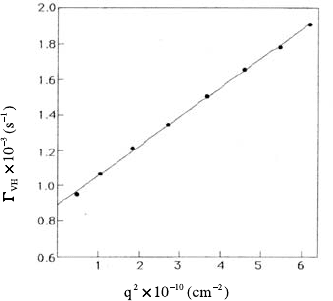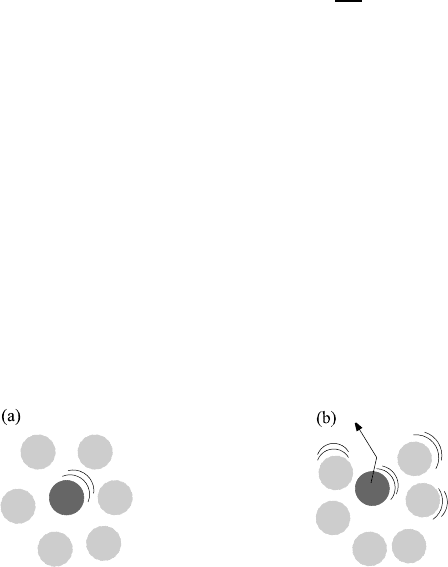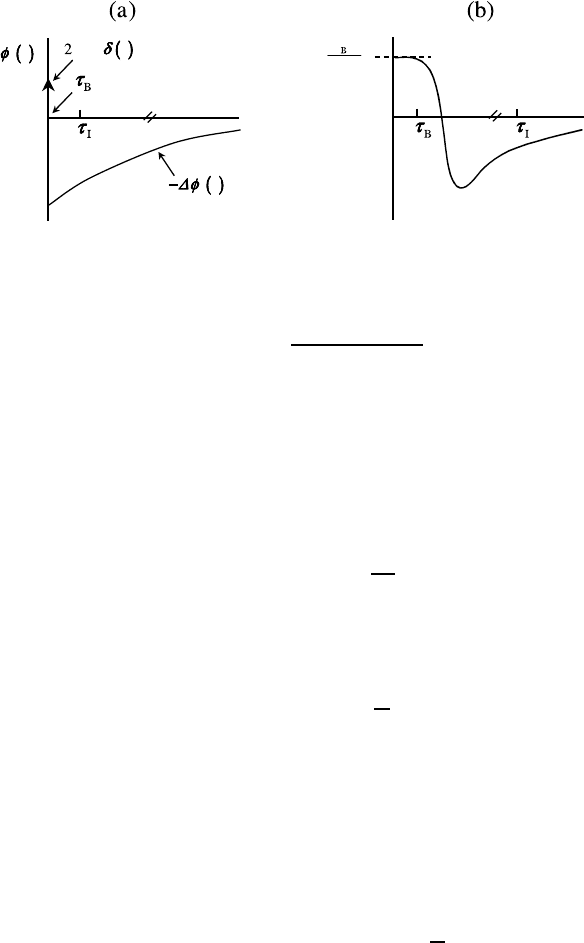Heitjans P., Karger J. (Eds.). Diffusion in Condensed Matter: Methods, Materials, Models
Подождите немного. Документ загружается.


630 Gerhard N¨agele, Jan K. G. Dhont, and Gerhard Meier
W (t) ∼ t
2
,t τ
B
. (16.30)
For times large as compared to the momentum relaxation time τ
B
, when the
sphere has experienced many collisions with solvent molecules, the MSD has
changed into a linear function of time, i.e.
W (t)=D
0
t, t τ
B
, (16.31)
where D
0
is referred to as the single particle or Stokes-Einstein diffusion
coefficient.
Thetimescaleτ
B
can be inferred from the following reasoning originally
due to Langevin. A sphere with velocity v experiences through the solvent
impacts an average friction force that is equal to −γ v,whereγ is referred
to as the friction coefficient, and a fluctuating force f (t). For a sphere, the
friction coefficient γ is given by the Stokes law γ =6πη
0
R,whereη
0
is the
shear viscosity of the solvent and R is the radius of the sphere. For times large
as compared with the mean collision time, τ
s
, of solvent molecules (typically,
τ
s
≈ 10
−13
s), the colloidal sphere has experienced many collisions by the
solvent molecules. Then the force f (t) can be described as a Gaussian dis-
tributed fluctuating quantity completely characterized by its first and second
moments
f(t) =0, f(t) · f (t
) =2dB δ(t − t
) . (16.32)
Here, ···is an average over the fast solvent collisions, and B is a measure of
the strength of the fluctuating force. In thermal equilibrium, B = k
B
Tγ, i.e.
the strength is proportional to the temperature and friction coefficient. The
delta function in time indicates that, as seen from a coarse-grained time level
t τ
s
, there is no correlation between solvent impacts at different times.
The Newtonian equation of motion for a Brownian sphere of mass M is
thus given, for times t τ
s
,by
M
dv
dt
= − γ v(t)+ f (t). (16.33)
with the solution
v(t) = v
0
exp
#
−
γ
M
t
$
(16.34)
for the solvent-collision-averaged velocity. As seen, the velocity remains on
average almost equal to the initial velocity v
0
for times t M/γ,whichsets
thetimescale
τ
B
≡
M
γ
=
M
6πη
0
R
(16.35)
for the average velocity relaxation of a colloidal sphere. For times t τ
B
,
the average velocity of a tagged particle decays towards zero. Using typical
values for aqueous colloidal dispersions, one finds that τ
B
≈ 10
−8
− 10
−9
s,
so that τ
B
τ
s
.

16 Diffusion in Colloidal and Polymeric Systems 631
So far we have considered the Brownian motion of a sphere with given
fixed initial velocity v
0
. In dynamic light scattering experiments, an addi-
tional average is performed with respect to a Maxwellian distribution of ini-
tial particle velocities since light is scattered from many spheres in thermal
equilibrium. Multiplication of (16.33) by v
0
and subsequent averaging over
solvent collisions and initial velocities gives
φ
v
(t) ≡
1
d
v(t) · v(0) =
k
B
T
M
exp
−
t
τ
B
(16.36)
for the velocity autocorrelation function (VAF), φ
v
(t), of an isolated Brown-
ian sphere. Due to equipartition of energy at equilibrium, v
2
(t) = dk
B
T/M.
Using that r(t) −r
0
=
-
t
0
dt
v(t
) one can easily show for stationary systems
that φ
v
(t) is related to the MSD by
W (t)=
t
0
du (t − u) φ
v
(u) . (16.37)
This relation is valid also for non-dilute system of interacting particles. The
MSD of an isolated sphere follows from the substitution of (16.36) into (16.37)
as
W (t)=D
0
t
1 −
τ
B
t
1 − e
−t/τ
B
→
k
B
T
2M
t
2
,τ
c
t τ
B
D
0
t, t τ
B
(16.38)
where D
0
is related to the friction coefficient by the Stokes-Einstein relation
D
0
=
k
B
T
γ
. (16.39)
Equation (16.38) interpolates between random ballistic flight for t τ
B
and
linear diffusive behavior for t τ
B
.
The sphere displacement ∆r(t) during time t is a Gaussian random vari-
able, since it is linearly related to v(t)andtof(t). The pdf, P (∆r,t), for
such a displacement is thus
P (∆r,t)={4πW(t)}
−d/2
exp{−
(∆r)
2
4W (t)
} (16.40)
with
W (t)=
1
2d
dr
d
P (∆r,t)(∆r)
2
. (16.41)
The pdf is the solution of the diffusion-like equation
∂
∂t
P (∆r,t)=D(t)∇
2
P (∆r,t) , (16.42)
where

632 Gerhard N¨agele, Jan K. G. Dhont, and Gerhard Meier
D(t) ≡
d
dt
W (t)=D
0
1 − e
−t/τ
B
, (16.43)
subject to the initial condition P (∆r,t=0)=δ(∆r). The latter follows from
(16.40) specialized to t = 0. Here, ∇ is the d-dimensional gradient operator.
Knowing the pdf we can calculate from (16.40) the self-dynamic structure
factor
S
s
(q, t)=
d(∆r)e
iq·∆r
P (∆r,t)=exp{−q
2
W (t)}, (16.44)
which, for uncorrelated spheres, depends on time only through W (t). Note
for the dilute dispersions of uncorrelated particles considered here that the
collective dynamic structure factor S
c
(q, t) reduces to the self-dynamic one.
In typical dynamic light scattering experiments on colloidal suspensions,
times t>10
−6
s τ
B
and hence distances large compared to (D
0
τ
B
)
1/2
are
resolved. In this so-called diffusive regime, (16.42) reduces to the one-particle
diffusion equation
∂
∂t
P (∆r,t)=D
0
∇
2
P (∆r,t) , (16.45)
which has (16.40) specialized to W (t)=D
0
t as its fundamental solution.
The diffusion (16.45) is statistically equivalent to the overdamped Langevin
equation
v(t)=
1
γ
f(t) , (16.46)
and f according to (16.32), which expresses a force balance, i.e an inertia-free
sphere motion for times t τ
B
.
In fact, Brownian motion of a colloidal particle is adequately described
by the Langevin equation (16.33) with δ-correlated random force only when
solvent inertia is negligible, i.e. for times t τ
B
only, where it reduces to
(16.46). The Langevin equation disregards, for shorter times t ≈ τ
B
,the
feedback on the particle velocity from the surrounding solvent. The solvent
cannot instantaneously follow the changes in the particle velocity. Through
the retarded response of the solvent, the sphere velocity is influenced by its
values at earlier times. This leads to an enlarged persistence in the velocity
autocorrelations. These solvent memory effects on the sphere velocity can
be adequately described, for d = 3 by the retarded (one-particle) Langevin
equation
M
dv
dt
= −
t
0
duγ(t − u) v(u)+ f(t) (16.47)
which includes a time-dependent friction function γ(t) obeying a generalized
fluctuation-dissipation relation
f(t) · f (t
) =3k
B
Tγ(t − t
) . (16.48)
The random force in the retarded Langevin equation is still Gaussian, how-
ever it is now correlated for different times, due to cooperative effects of the

16 Diffusion in Colloidal and Polymeric Systems 633
fluid motion. The friction function can be calculated, for times t τ
s
,using
macroscopic equations of motion for the solvent flow. Substitution of the hy-
drodynamically determined γ(t) into the retarded Langevin equation results
in closed expressions for the MSD and φ
v
(t). We only quote the asymptotic
forms valid for t τ
η
, viz. [6–8]
W (t) ≈ D
0
t
1 −
2
√
π
τ
η
t
1/2
(16.49)
and
φ
v
(t)=
d
2
dt
2
W (t) ≈
1
9
√
π
k
B
T
m
t
τ
η
−3/2
(16.50)
where τ
η
= a
2
ρ
s
/η
0
=(9/2)(ρ
s
/ρ
M
)τ
B
is the time needed for a viscous shear
wave in the solvent of mass density ρ
s
to diffuse across a particle radius. The
mass density, ρ
M
, of colloidal particles is close to ρ
s
,andτ
η
and τ
B
are thus
of the same order of magnitude.
The positive feedback of the solvent flow on the sphere velocity implies an
algebraic rather than exponential decay of the VAF. Moreover, the algebraic
approach of the single-particle MSD to its long-time-limiting form W (t)=
D
0
t is much slower than prediced by (16.38). The occurrence of an algebraic
decay in an autocorrelation function is generally referred to as a long-time
tail. An algebraic tail proportional to t
−1/2
in W (t) was indeed observed in
dynamic light scattering experiments on very large colloidal spheres (since
τ
B
∝ a
2
) through the measurement of S
s
(q, t) and using (16.44) to infer
W (t) [9]. While the non-retarded Langevin equation does not describe dilute
colloidal dispersions for times t ≈ τ
B
, it can be applied instead for t ≈ τ
B
to
aerosols like dust or smoke particles in air, since for these systems one has
ρ
s
ρ
M
and hence τ
η
τ
B
.
The surrounding solvent molecules exert in addition to a random force
a random torque, f
r
(t), on the colloidal sphere, which causes a rotational
Brownian motion of its angular velocity ω(t). Neglecting solvent inertia, the
erratic sphere rotation can be described in analogy to translational motion
by a rotational Langevin equation, given for d =3andt τ
s
by
M
r
dω
dt
= − γ
r
ω(t)+ f
r
(t) , (16.51)
with a stochastic torque of zero mean and δ-correlated covariance
f
r
(t) · f
r
(t
) =6k
B
Tγ
r
δ(t − t
) . (16.52)
According to this Langevin equation, the solvent-collisions-averaged angular
velocity and the equilibrium angular VAF are, respectively,
ω(t) = ω
0
exp
−
t
τ
r
B
(16.53)

634 Gerhard N¨agele, Jan K. G. Dhont, and Gerhard Meier
and
φ
ω
(t) ≡
1
3
ω(t) · ω(0) =
k
B
T
M
r
exp
−
t
τ
r
B
(16.54)
with the damping time
τ
r
B
=
M
r
γ
r
. (16.55)
Here, γ
r
=8πη
0
a
3
is the so-called Stokes-Debye friction coefficient of a freely
rotating sphere, and M
r
=(2/5)Ma
2
is the moment of inertia of a homoge-
neous sphere. The damping times for the translational and rotational velocity
are of the same order of magnitude, since τ
r
B
=(3/10)τ
B
.
When the hydrodynamic solvent-sphere coupling is accounted for through
a time-dependent rotational friction function similar to the translational case,
the exponential decay of the rotational VAF is changed for times t τ
η
into
the power-law decay [10, 11]
φ
ω
(t) ≈
1
60
√
π
k
B
T
M
r
t
τ
η
−5/2
(16.56)
which is one power in t slower than the asymptotic decay of the trans-
lational VAF. Depolarized dynamic light scattering is a convenient experi-
mental tool to measure rotational Brownian motion of optically anisotropic
spheres in the diffusive regime t τ
B
. As mentioned in Sect. 16.2.1, the
polarizability, α, of an optically anisotropic uniaxial sphere is a tensor
α(
ˆ
u)=α
ˆ
u
ˆ
u + α
⊥
(1 −
ˆ
u
ˆ
u)=α 1 + β
ˆ
u
ˆ
u −
1
3
1
(16.57)
where α
and α
⊥
are the incremental (relative to the solvent) polarizabilities
parallel and perpendicular to the optical axis of the sphere, with α =(α
+
2α
⊥
)/3andβ = α
− α
⊥
,and
ˆ
u(t) is the unit orientation vector pointing
along the optical axis. The orientation vector is related to the angular velocity
of the sphere by ω(t)=
ˆ
u(t) × (d/dt)
ˆ
u(t).
In depolarized dynamic light scattering, the polarization of the incident
electric light field is chosen perpendicular to the scattering plane spanned
by the incident and detected light beam (i.e.
ˆ
n
0
=
ˆ
n
V
), and one detects
the in-plane component (i.e.
ˆ
n
s
=
ˆ
n
H
) of the scattered electric field. In this
VH-geometry
ˆ
n
s
· α(
ˆ
u) ·
ˆ
n
0
= β
2π
15
1/2
[Y
2,1
(
ˆ
u)+Y
2,−1
(
ˆ
u)] (16.58)
where Y
2,m
is a second-order spherical harmonic function. Together with
(16.15), this results in the EACF [3]
g
VH
E
(q, t) ∝ β
2
S
s
(q, t) S
r
(t) (16.59)

16 Diffusion in Colloidal and Polymeric Systems 635
where we have introduced the rotational self-dynamic correlation function
S
r
(r)=4πY
2,−1
(
ˆ
u(0)) Y
2,1
(
ˆ
u(t)) = P
2
(
ˆ
u(t) ·
ˆ
u(0)), (16.60)
which includes information on the rotational diffusion. The second equality
follows from spatial isotropy, i.e. from the m-independence of S
r
(t), with P
2
denoting the second-order Legendre polynomial. In deriving (16.60), it has
been assumed that the rotational motion of a sphere is decoupled from the
translational motion for all t τ
B
. While this decoupling is strictly valid for
dilute dispersions of non-interacting spheres, it is an approximation for non-
spherical particles and for concentrated sphere dispersions. Note that β =0
for optically isotropic spheres. Then there is no depolarized scattered light
as long as multiple light scattering is negligibly small.
The function S
s
(q, t) of non-interacting spheres can be calculated for t
τ
B
from the rotational diffusion equation (Debye equation)
∂
∂t
P (
ˆ
u,t)=D
r
0
ˆ
L
2
P (
ˆ
u,t) (16.61)
which determines the pdf P (
ˆ
u,t) of finding the sphere with orientation
ˆ
u at
time t. We have introduced here the diffusion coefficient of a single and freely
rotating sphere, related to the rotational friction coefficient by the Einstein-
Debye relation
D
r
0
=
k
B
T
γ
r
. (16.62)
The Debye equation is the analogue of the translational diffusion equation
(16.45), with
ˆ
L =
ˆ
u × ∂/(∂
ˆ
u) denoting the gradient operator in orientation
space. It describes the random walk of the tip of
ˆ
u(t) on the unit sphere.
Equation (16.61) has the fundamental solution [3]
P (
ˆ
u,t|
ˆ
u
0
)=
∞
l=1
l
m=−l
Y
lm
(
ˆ
u) Y
l,−m
(
ˆ
u
0
)exp{−l(l +1)D
r
0
t} , (16.63)
which is the probability density for a sphere to have orientation
ˆ
u at time t
given that it had orientation
ˆ
u
0
at initial time t = 0. The rotational function
S
r
(t)isthencalculatedas
S
r
(t)=
d
ˆ
u
d
ˆ
u
0
Y
2,1
(
ˆ
u) Y
2,−1
(
ˆ
u
0
)P (
ˆ
u,t|
ˆ
u
0
)=exp
+
−6D
0
r
t
,
(16.64)
where we have employed the orthogonality relations of the spherical har-
monics. As a consequence, the depolarized EACF of non-interacting sphere
dispersions is
g
VH
E
(q, t) ∝ β
2
exp
+
−
q
2
D
0
+6D
r
0
t
,
. (16.65)

636 Gerhard N¨agele, Jan K. G. Dhont, and Gerhard Meier
Fig. 16.3. Initial decay rate Γ
VH
=−lim
t→0
(d/dt)lng
VH
E
(q, t) of depolarized EACF
versus q
2
, for a dilute dispersion of anisotropic teflon spheres (Φ =0.02). After [12].
One can determine D
0
and D
r
0
simultaneously from the EACF by plotting the
time derivative of −ln g
VH
E
(q, t)versusq
2
, yielding a straight line of slope D
0
and intercept D
r
0
. Plots of this kind are shown in Fig. 16.3 for depolarized
DLS experiments on a dilute dispersion of anisotropic teflon spheres [12].
The particle diameters determined from D
0
and D
r
0
, respectively, are indeed
nearly identical.
From employing the fundamental solution, one can further calculate the
orientation autocorrelation function
ˆ
u(t) ·
ˆ
u(0) =exp{−t/τ
r
} (16.66)
and the orientation MSD [13]
[
ˆ
u(t) −
ˆ
u(0)]
2
=2
1 − e
−t/τ
r
→
4D
r
0
t, τ
r
B
t τ
r
2 ,t τ
r
(16.67)
where τ
r
=1/(2D
r
0
) is the orientation relaxation time. The tip of
ˆ
u(t)per-
forms, for t τ
r
, a two-dimensional random walk on the tangential surface
touching the unit sphere at
ˆ
u
0
. The MSD saturates to 2 for times t τ
r
,
since |
ˆ
u(t) −
ˆ
u(0)|≤2 for all t. Typical values of τ
r
are 10
−4
−10
−3
swhich
implies the following sequence of time scale separations
τ
s
τ
η
≈ τ
B
≈ τ
r
B
τ
r
(16.68)
valid for the translational/orientational self-diffusion of non-interacting glob-
ular particles.
16.3.2 Diffusion Mechanisms in Concentrated Colloidal Systems
While the diffusion of a non-interacting sphere is completely described by
its MSD, which is linear in time in the diffusive time regime t τ
B
,various

16 Diffusion in Colloidal and Polymeric Systems 637
diffusion processes have to be distinguished in non-dilute dispersions of inter-
acting colloidal spheres. These diffusion processes are controlled by different
diffusion coefficients which become equal to each other only in the dilute limit
when the sphere interactions can be ignored. The spheres influence each other
indirectly through the solvent flow field in which they move. These so-called
hydrodynamic interactions (HI) propagate on a time scale τ
η
≈ τ
B
,sothat
they act quasi-instantaneously on the diffusive time scale where the fast mo-
mentum relaxations of the spheres are not resolved any more. HI affects the
sphere dynamics but not the equilibrium microstructure, since as dissipative
forces they are not describable in terms of an interaction potential. In addi-
tion to the HI, the spheres can have potential interactions with each other
through excluded volume, van der Waals and screened electrostatic forces.
These direct forces become operative on the interaction time scale τ
I
,which
is the time after which a particle experiences a substantial change of the po-
tential interactions through a perceptible change in its next neighbor sphere
configuration. Very roughly, τ
I
can be estimated for a fluid-like suspension as
the time needed for a sphere to diffuse across its own radius, viz.
τ
I
≈
a
2
D
0
, (16.69)
with typical values of 10
−4
−10
−3
s.Theshort-timeregimeτ
B
t τ
I
,for
DLS is thus well separated from the long-time regime t τ
I
.
Self-Diffusion
For short times τ
B
t τ
I
, a sphere diffuses only over a distance small as
compared to its own size, and the dynamic “cage” of neighboring spheres has
thus hardly changed (as sketched in Fig. 16.4a). The sphere diffuses then, on
the average, in a potential minimum of the neighboring particles and is thus
influenced only by the instantaneously acting HI. A linear increase
W (t)=D
s
s
t, τ
B
t τ
I
(16.70)
of the MSD is thus observed at short times, with a short-time self-diffusion
coefficient, D
s
s
, smaller than the Stokesian diffusion coefficient, D
0
, at infinite
Fig. 16.4. Schematic view of a particle cage around a colloidal sphere for (a) short
times τ
B
t τ
I
and (b) long times t τ
I
.
638 Gerhard N¨agele, Jan K. G. Dhont, and Gerhard Meier
dilution, owing to the slowing influence of HI. Note that the subscript s in D
s
s
stands for “self” and the superscript for “short”. At intermediate times t ≈
τ
I
, the cage becomes distorted from its equilibrium spherical symmetry and
the sphere experiences an additional hindrance by potential forces. The cage
distortion implies a sub-linear time dependence of W (t). For long times t
τ
I
, a sphere has experienced many independent collisions with neighboring
spheres, as sketched in Fig. 16.4b.
This leads again to a linear time-dependence of W(t)
W (t)=D
l
s
t, t τ
I
, (16.71)
but with a long-time self-diffusion coefficient, D
l
s
, smaller than the short-time
one. Summarizing,
0 ≤ D
l
s
≤ D
s
s
≤ D
0
, (16.72)
and one can show that this ordering is valid independent of the type of
potential interactions. All three diffusion coefficients are equal to D
0
in the
absence of interactions only, whereas D
l
s
is substantially smaller than D
0
for strongly interacting particles. On approach of a glass-transition point, a
particle gets eventually trapped in its next-neighbor cage, with a complete
blocking of its long-range motion characterized by D
l
s
≈ 0 (idealized glass
transition scenario). In contrast, D
s
s
> 0 since a sphere in a glass can still
perform short-time Brownian motion within its cage.
Using (16.37), D
l
s
can be expressed as a Green-Kubo relation
D
l
s
=
∞
0
dtφ
v
(t) (16.73)
i.e. in form of a time integral over the VAF. On the coarse-grained level
t τ
B
,theVAF
φ
v
(t)=2D
s
s
δ(t) − ∆φ
v
(t) (16.74)
of interacting spheres consists of a singular part proportional to D
s
s
,such
that (16.70) is retained from (16.37), and a long-lived negative part, −∆φ
v
(t),
originating from particle interactions (caging). One can show that ∆φ
v
(t) > 0
and (d/dt)∆φ
v
(t) < 0, consistent with D
l
s
<D
s
s
. The regular part of the VAF
is thus negative and increases strictly monotonically towards its final value
zero. As one expects intuitively, the collective retarding effect of neighboring
spheres leads to anti-correlations in the particle velocity. The positive-valued
singular part in the VAF is the residual of the fast initial decay of velocity
correlations mediated through the intervening solvent, and manifests itself as
a δ-function for t τ
B
(see Fig. 16.5).
Substitution of (16.74) in (16.37) gives
W (t)=D
l
s
t + τ
m
D
s
s
− D
l
s
−
∞
t
du(u − t)∆φ
v
(u) , (16.75)
where

16 Diffusion in Colloidal and Polymeric Systems 639
s
s
V
V
kT
M
D
t
t
t
t
t
Fig. 16.5. Schematic VAF in (a) the diffusive regime t τ
B
, and (b) at very short
times so that the initial δ-peak is resolved.
τ
m
≡
-
∞
0
dtt∆φ
v
(t)
-
∞
0
dt∆φ
v
(t)
(16.76)
is the mean relaxation time of ∆φ
v
(t). It is roughly comparable to τ
I
.The
last term on the right-hand side of (16.75) is the difference between W (t)and
its long-time asymptote. The asymptote crosses the vertical axis at the point
τ
m
D
s
s
− D
l
s
. A remarkable feature of W (t) is that the approach towards
its long-time form in (16.71) is very slow. In three dimensions, the VAF of a
suspension of hard colloidal spheres has a negative long-time tail [14]
φ
v
(t)=−∆φ
v
(t) ≈−A
t
τ
m
−5/2
,t τ
m
(16.77)
with an amplitude A>0 that depends on the sphere concentration. The
MSD for large t is consequently
W (t) ≈ D
l
s
t + τ
m
D
s
s
− D
l
s
1 −
t
τ
l
−1/2
+ O(t
−1
) , (16.78)
where τ
l
is a typical time scale related to τ
m
. Fig. 16.6 displays a sketch of a
three-dimensional MSD.
The relaxation of the VAF becomes extremely slow in two dimensions
where φ
v
(t) decays asymptotically as t
−2
for all concentrations, independent
of the nature of the interactions. Therefore, the two-dimensional MSD in-
cludes a logarithmic long-time correction [15]
W (t) ≈ D
l
s
t + τ
m
D
s
s
− D
l
s
ln
t
τ
l
+ O(1) (16.79)
with diffusion coefficients and decay times different from the three-dimensional
case. We emphasize that the negative VAF long-time tails discussed above
are due to configurational rearrangements of interacting spheres, and they
should not be confused with the positive long-time tail in (16.50). The latter
